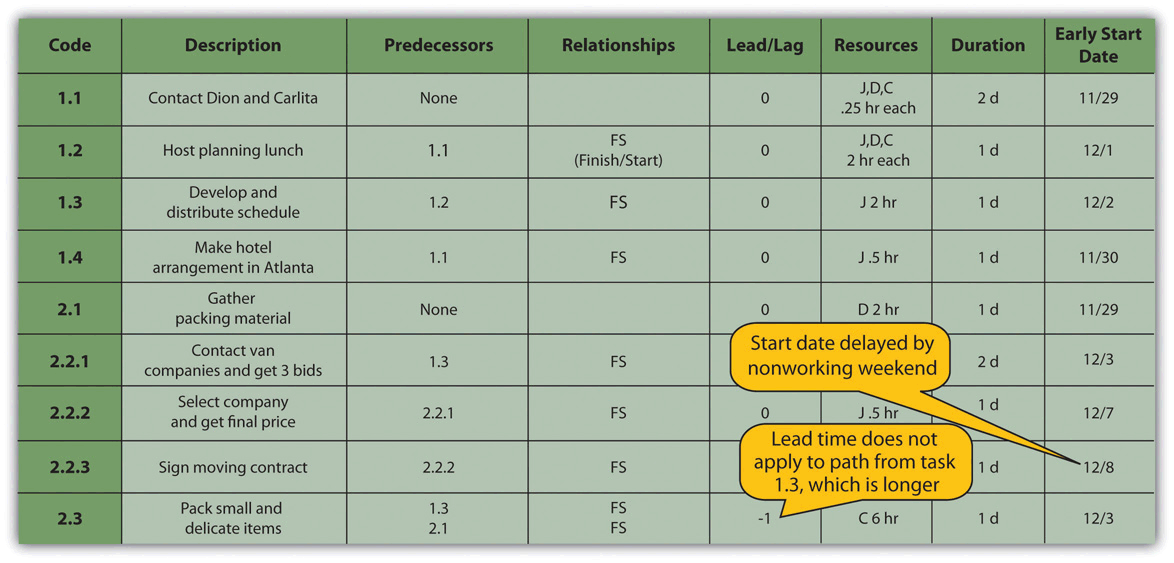8.3 Critical Path and Float
Visit Audio Recordings for the audio version of this section.
LEARNING OBJECTIVE
- Calculate critical path, project float, early start dates, and late start dates.
The critical path is the path through the network that results in the latest completion date of the project.

If any activity on the critical path is delayed, the completion of the project will be delayed by an equal amount. To determine the critical path, add the amount of time estimated for the duration of each activity to the previous activity, as shown in Figure 8.10. Durations are indicated in days and activities on the critical path are shaded. The critical path through these tasks takes at least eight days.
Figure 8.10 Critical Path

Early Start Dates
Starting dates can be assigned to each activity by doing a forward pass proceeding from left to right in the network diagram beginning with the project start date. The dates derived by this method are the early start (ES) dates. The early start date for an activity is the earliest date the activity can begin. The estimate considers durations and resource availability calendars. To calculate early start dates, begin with the project start date and assign that date as the start date of activities that have no predecessor activities. Follow these steps to calculate the early start dates of subsequent activities, assuming finish-start relationships:
- Add the predecessor activity’s duration to its start date.
- Add the lag time or subtract the lead time.
- Refer to the resource calendar(s) that applies to the people and equipment necessary for the activity, and add the number of off-days that the activity would span on those calendars.
- Assign the calculated date as the early start date of the successor activity.
Forward Pass for John’s Move
Figure 8.11 Early Start Dates Determined by a Forward Pass

Doing this process manually is error prone and time consuming. Fortunately, there are computer programs to assist in the process, but the project manager must understand the process well enough to recognize computer errors. Computer software must be combined with common sense or good judgment.
Float
Float, sometimes called Slack (float), is the amount of time an activity, network path, or project can be delayed from the early start without changing the completion date of the project.
Total float is the difference between the finish date of the last activity on the critical path and the project completion date. Any delay in an activity on the critical path would reduce the amount of total float available on the project. A project can also have negative float, which means the calculated completion date of the last activity is later than the targeted completion date established at the beginning of the project.
If activities that are not on the critical path have a difference between their early start date and their late start date, those activities can be delayed without affecting the project completion date. The float on those activities is called free float.
Float in John’s Move
Figure 8.12 Total Project Float

Late Start Dates
The next step is to work through the network diagram from right to left beginning with the mandated completion date, which is a milestone that is set in the project plan. Subtract the duration of each activity in each path to determine the latest date the activity could begin and still meet the project completion date. Resource calendars must be considered in the backward pass as well as the forward pass.
To calculate late start dates, begin with the project completion milestone and assign that date as the finish date of its predecessor activities. Follow these steps to calculate the late start dates of predecessor activities, assuming finish-start relationships:
- Subtract the predecessor activity’s duration from its late finish date.
- Subtract the lag time or add the lead time to the late finish date.
- Refer to the resource calendar(s) that applies to the people and equipment necessary for the activity, and subtract the number of off days that the activity would span on those calendars.
- Assign the calculated date as the late start date of the predecessor activity.
The difference between the early start date and the late start date for activities on the critical path is usually the same as the total float, unless the activities are affected by the resource calendars differently in the forward and backward pass. For example, if a piece of key equipment is only available for a few days, activities that depend on it have the same start and finish dates in the forward and backward passes.
KEY TAKEAWAYS
- To calculate total project float, begin at the start date and add the duration of each activity in each possible path through the network diagram, including nonworking days from the resource calendars, to determine the early project end date. The longest path through the network is the critical path. The difference between the early end date and the required completion date of the project is the total project float, and the start date of each activity is the early start date. To calculate the late start dates, begin with the required project completion date and work backward, subtracting the duration of each activity though each possible pathway.
The path through the network that results in the latest completion date of the project.
The earliest date the activity can begin.
Activities that have predecessor-successor relationships occur sequentially—one after the other.
An account of time must go by before a successor activity can begin.
The successor activity can overlap the end of its predecessor activity and begin before the predecessor is finished.
A calendar that indicates which days they are available and which are days off to consider the availability of team members, consultants, and vendors.
If the critical path takes less time than is allowed by the client to complete the project, the project has a positive total float or project slack. If the client’s project completion date precedes the calculated critical path end date, the project has negative float.
The difference between the finish date of the last activity on the critical path and the project completion date.
The calculated completion date of the last activity is later than the targeted completion date established at the beginning of the project.
Activities that are not on the critical path have a different between their early start date and their late start date, those activities can be delayed without affecting the project completion date.

